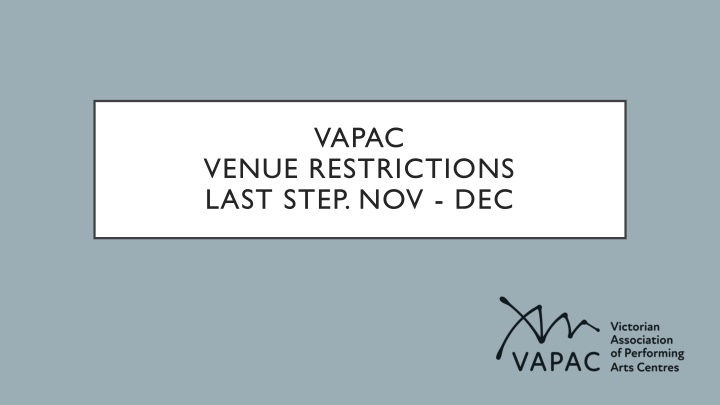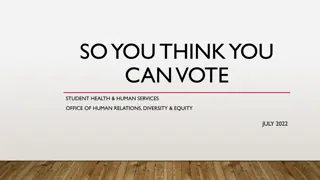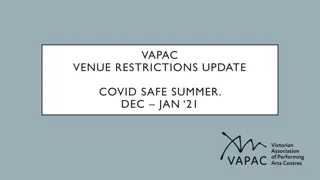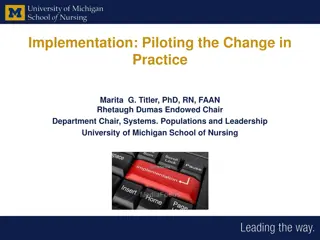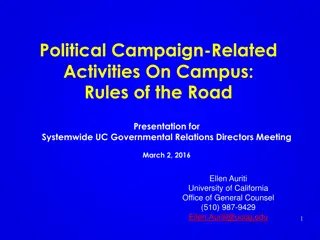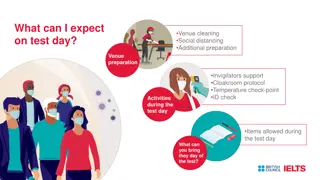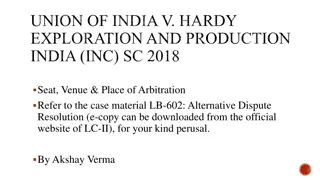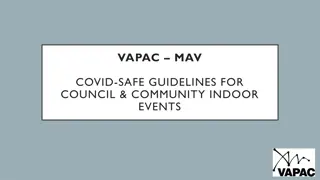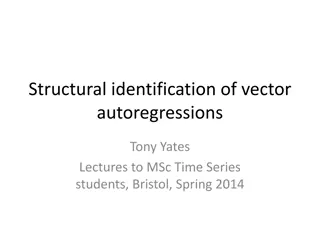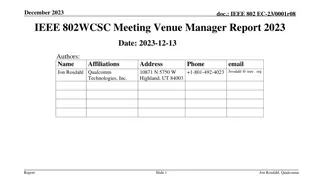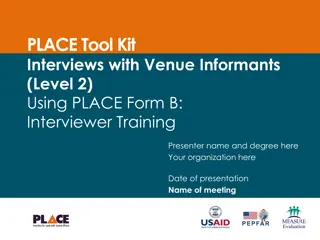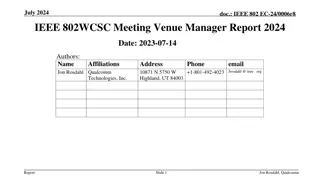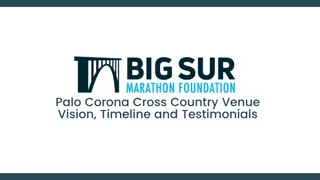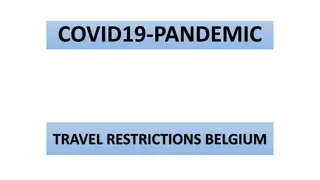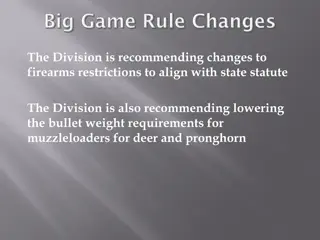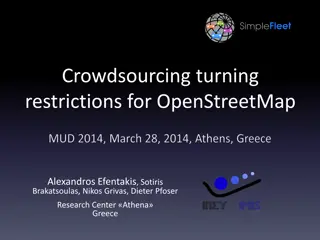VAPAC VENUE RESTRICTIONS LAST STEP. NOV - DEC
Within the dynamic scope of "VAPACVENUE.RESTRICTIONS.LAST.STEP..NOV.-.DEC", navigating through the constraints and opportunities present during November and December is a vital aspect to consider for successful outcomes.
Uploaded on Mar 01, 2025 | 3 Views
Download Presentation

Please find below an Image/Link to download the presentation.
The content on the website is provided AS IS for your information and personal use only. It may not be sold, licensed, or shared on other websites without obtaining consent from the author.If you encounter any issues during the download, it is possible that the publisher has removed the file from their server.
You are allowed to download the files provided on this website for personal or commercial use, subject to the condition that they are used lawfully. All files are the property of their respective owners.
The content on the website is provided AS IS for your information and personal use only. It may not be sold, licensed, or shared on other websites without obtaining consent from the author.
E N D
Presentation Transcript
VAPAC VENUE RESTRICTIONS LAST STEP. NOV - DEC
LAST STEP. VENUES < 600 Indoor seated up to 600 seat venues open for a maximum of 150 people per space Subject to the density quotient of 1 person per 4 square metres whichever is the lesser. Up to 20 people in any group booking. (Not inc. < 12 months) Physical distancing of 1.5 metres between groups. Performance or screening times must be staggered, at least a 30-minute interval between sessions. Dining areas comply with current Hospitality Guidelines
LAST STEP. VENUES > 600 Indoor seated 600+ seat venues up to a maximum of 25% of capacity. Subject to the density quotient of 1 : 4 sqm in all spaces other than the seated auditorium Physical distancing of 1.5 metres between groups. Up to 20 people in any group booking. (Not inc. < 12 months) Must Publish COVIDSafe Plan Performance or screening times must be staggered, at least a 30-minute interval between sessions. Dining areas comply with current Hospitality Guidelines
OUTDOOR. SEATED For outdoor entertainment, attractions and experiences Outdoor seated venues - allowed 50% seated capacity up to a maximum of 500 people. (the lesser of) No requirement to apply density quotient of 1 : 4 sqm Physical distancing of 1.5 metres between groups. Maximum group limit of 50 People as per outdoor gatherings Other Indoor spaces: subject to restrictions on hospitality, retail, indoor seated or indoor non-seated venues depending on the space.
OUTDOOR. NON-SEATED For outdoor entertainment, attractions and experiences Non-Seated: Subject to density quotient of 1 person per 4 square metres. Capacity of greater than 500 people to publish COVIDSafe Plan Physical distancing of 1.5 metres between groups. Maximum group limit of 50 People as per outdoor gatherings Other Indoor spaces: subject to restrictions on hospitality, retail, indoor seated or indoor non-seated venues depending on the space.
PERFORMER RESTRICTIONS A distance of 5 metres between performers and the audience is now Recommended. It is not mandated. A physical distance of 1.5 metres is required between most performers however A physical distance of 2 metres is required between performers who are singers or wind instrumentalists. A distance of 3 metres is required in the direction of airflow for non- reeded wind instruments such as flutes and recorders.
PERFORMER RESTRICTIONS #2 Amateur singers wind players. Recommended no more than 5 people per space but not mandated. Masks Outdoor performers. Only required to be worn if unable to keep a safe distance (e.g. 1.5m) Masks Indoor performers. Must wear masks unless it would impede performance Where physical distancing is not possible, including with staff who work backstage with performers, limit the duration of close contact Performers are excluded from venue capacity caps.
THE WORKPLACE Workplaces currently working from home (such as offices in the CBD) to return for up to 25 per cent of their workforce per site from 30 November 2020 Unless you re one of those people nominated by your employer, you will need to keep working from home. Standard workplace requirements including density limits continue to apply Businesses with fewer than 40 staff can have 10 staff on-site subject to density quotients.
CONTACT TRACING Businesses must keep a record of those details, and the date and time at which the person attended the facility. Where the patrons spend most of their time in a single space (i.e. a theatre), a record of the space used should also be kept. There is no need to keep multiple records if patrons move through multiple spaces. Records can be kept electronically or in hard copy. Records should be kept for 28 days. The record keeping requirement applies to all persons attending a facility or venue for longer than 15 minutes, which may include staff, customers, maintenance and delivery workers. VIC QR Code is one Option. Data Verification? Software options.
GOVT GUIDELINES The updated Industry Restart Guidelines - Indoor Entertainment Venues - still no available Outdoor Entertainment, Attractions and Experiences is available. https://www.coronavirus.vic.gov.au/coronavirus-sector-guidance- arts-and-recreation-services The is a clear, comprehensive and practical document. the FAQ for our sector has not been updated yet, and neither have the Creative Vic Q&As
PUBLIC EVENT FRAMEWORK When an entertainment facility hosts an activity which fulfils the definition of a one-off public event, organisers may apply for their activity to be considered under the Public Events Framework (PEF). Examples include an exhibition, festival, fair, parade, or performance. However: Most routine, ordinary, day to day operations of a venue or facility including Indoor and Outdoor are expected to remain subject to the requirements of the published directions for those activities, not the PEF. A public event is not: a private or public gathering of members of the public in a facility, venue, indoor space or outdoor space for ordinary, day-to-day operations, use, activities or services https://www.coronavirus.vic.gov.au/public-events- information-for-organisers
Public Event Framework - TIERS The Public Events Framework applies to events in three categories: 1. Tier 1: highly complex and involving more than 5,000 attendees 2. Tier 2:moderately complex involving 500-5,000 attendees 3. Tier 3 low complexity and involving 500 attendees or less Tier 1 and 2 public events are required to submit a COVIDSafe Event Plan for review and approval by the Victorian government. DJPR and DHHS / CHO Tier 3 events; self-evaluate; published guidelines. Develop and upload a COVIDSafe Event Checklist. Need to publish online. Implement.
Public Event Framework - PROCESS On Line Registration and Assessment Process https://www.coronavirus.vic.gov.au/public-events 1. Tier 1 events should be registered 8 to 10 weeks before event start date. 2. Tier 2 events should be registered 4 to 6 weeks before the event start date. 3. Tier 3 events should be registered 1 week before the event. Other risk factors may mean that an event is classified at a higher tier and will require approval If a Tier 3 event has four or more of the event risk factors it will be recategorised as a Tier 2 event If a Tier 2 event has six or more of the risk factors it will be recategorised as a Tier 1 event
Public Event Framework RISK FACTORS 1. Is the event primarily held indoors? 2. Does the event promote attendees to stand and roam around the venue? 3. Is alcohol served at the event? 4. Is there extensive singing, chanting, cheering or exhaling during the event? 5. Is there close physical interaction between attendees and/or participants where they may not be able to maintain 1.5 metres distance for short periods of time? 6. Is the event held over multiple successive days with different attendees each day? 7. Will the event include participants or attendees from interstate?
Public Event Framework PHASES Now 25% of capacity up to 500 Max Phase 1 - 50% of the venue s seating capacity, up to 5,000 people seated. Density quotient of one person per four square metres applies to non-fixed seated areas e.g. grassed areas. Allocated seated events only. Free-standing events not permitted. Phase 2 50% of the venue s seating capacity, up to 25,000 people seated. Density quotient of one person per four square metres applies to non-fixed seated areas e.g. grassed areas. Allocated seated events only. Free-standing events not permitted. Phase 3 up to 100%. Possibly by Late January
COVIDSafe Plan All operations are subject to having a COVIDSafe Plan The Six COVIDSafe Principles apply 1. Ensure Physical Distancing 2. Masks all workers, patrons, performers unless a lawful exemption 3. Good hygiene cleaning 4. Record Keeping contact tracing act quickly process 5. Avoid enclosed spaces 6. Create workforce bubbles 7. The VAPAC COVID Safe Plan Template V 4.1 has been re- structured to be aligned with the COVID Safe Principles & templates
